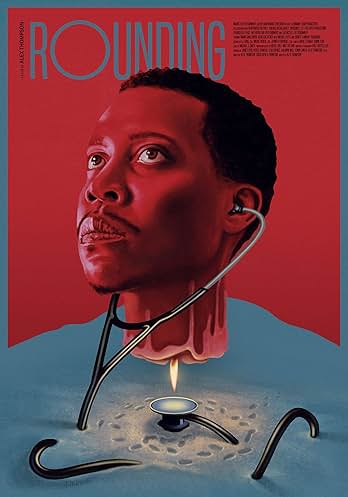“Rounding” (2022), which is opening digitally on March 25, 2025, is defined as visiting patients, but according to opening scene, Apollo, the god of healing, and the mortal Coronis had a demi-god son named Asciepius, the god of medicine, and when patients dreamed, he would visit them. Enkoimesis, also known as incubation, was the oneiric space where Asciepius and his patient met, and the treatment sounds supernatural, including exorcism. Promising junior resident, Dr. James Haymin (Namir Smallwood), starts working at a rural hospital after having a nervous breakdown, but when he geta a patient, Helen Adso (Sidney Flanigan), whose symptoms are not aligned with the test results, his second chance begins to look like his last as everyone loses faith in him, and strange visions plague him. Even though he is falling apart, he refuses to prioritize his well-being over the patient, but will sacrificing himself make a difference?
“Rounding” is a compilation of intriguing parts that do not make a cohesive whole. It is about a young confident doctor who falls apart at his first misstep and how futile medicine is in the face of the unknowable parts that cannot get definitively tested. Being a good doctor is a compilation of lots of factors: expertise, personality and instinct. A thread throughout the character study is the question of whether James is delusional, not living a healthy lifestyle or has the unspoken pressure of high expectations. It does not matter because director and cowriter Alex Thompson conveys how James sees everything as a threat or suspicious, and the energy that he puts into the world boomerangs back at him.
For example, when someone knocks at the door, it has the loud thud that evokes law enforcement, but it is just his housemate, Carol (Max Lipchitz). When it gets bad, James starts seeing horror elements emerge from the shadows, loses time and eyes religious symbols and artwork as signs of something more sinister. This type of horror will be disappointing if a moviegoer expects it to be more than seasoning. It is another example of expressionist horror, which depicts real life fears as if it is supernatural so the viewer can have the same psychological experience as the protagonist. Unfortunately, James’ fear is so diffuse that this aspect does not work. What is the multiheaded light bulb monster? No idea, and reach out if you know. It initially appears in some hospital artwork with some calligraphy, so the writing is impossible to decipher and read onscreen. When filmmakers use this narrative technique, it is to zhush up something that would be dull if played straight.
The horror carries more weight when James seems to harness his dream powers to communicate with remote patients. Is it a dream or is it happening as much for the patient as the beleaguered physician? Is James such a good doctor because he has this godlike power and can tap into it or is it just a dream, wishful thinking, his psyche processing the day’s problems? This question is never answered though it does contain a thread of truth. In his dreams, he can explore unprocessed ideas in his life by subconsciously projecting them on to his patient. Apollo is associated with poetry, which James discusses with his first on-screen patient, Vivian Spurlock (Cheryl Lynn Bruce).
Smallwood’s soft spoken, fractured performance makes an unreliable character into someone still capable of excellence but should probably redirect some of that care to himself. Within the first five minutes, I knew the root of James’ trauma, which is laid out in plodding detail in the end. His colleagues do not know his backstory, yet they start to doubt him and question his judgment early in the story. Racism gets eliminated because Dr. Emil Harrison (Michael Potts) is the attending, and everyone loves him despite his reassuring stories lined with red flags and disturbing reaction to James revealing that he suffers from nightmares only elicits a cheery, “Good! You’re sleeping.” Even though James is not running on all cylinders, his concern seems appropriate compared to how everyone else is so chill about life and death. Even the patients find James’ intense level of care off-putting. Indeed, he is a bit of stalker or a detective if you’re feeling generous, but everyone’s patronizing attitude feels like the real nightmare. He can be a madman and correct.
Well, James pegs some things correctly and misjudges others. The audience will be absorbed in trying to decipher the clues, but because Thompson and his brother and cowriter Christopher Thompson do not stick to a lane, the payoff will feel anticlimactic. If Alex Thompson sounds familiar, he completed this film before “Ghostlight” (2024), which he codirected with Kelly O’Sullivan, who appears in “Rounding” as Dr. Kayla Matthews and was endearing in “Hangdog” (2023). In both of his films, the protagonist uses art, specifically acting, to handle trauma instead of therapy. If the exercises bled into his professional life, it would be powerful. It does not quite work here because it seems cruel to force James to stand on his feet when he is clearly limping to make a point, and it carries the weight of a vignette.
Thompson makes a great montage in establishing then disrupting James’ routine. Focusing on James’ feet is a superb way of elaborating on the theme that people lie, bodies do not. His feet communicate his psychological and eventually his physical health. Even the way that James slides his shoes onto his feet is particular, fastidious and proper. At one point, you will have to look away from the exaggerated state of his feet.
Cinematographer Nate Hurtsellers is better at exteriors than interiors for home viewers. Even though the interior darkness may be deliberate, it should not be inscrutable. People start to blend in the shadows. The atmosphere could be portentous, but the protagonist should not disappear. It is difficult to light different skin tones simultaneously, but it is possible. There is one shot that is so perfect that it was either staged or timed meticulously. James is an avid runner, and he ascends stairs at dusk just as the streetlights come on as he ascends. All the running scenes seem essential.
“Rounding” should come with a slight trigger warning. There is a suicidal theme that comes up casually as James moves into his room and hears about the prior inhabitant. The suicidal theme is about death, confusing wanting to die with the desire to receive care and how the ramification damage their caretakers pitting them at odds with the people capable of saving their dependents. It will take a lot of reflection for most to draw this conclusion from watching this film, but it is an interesting concept that should have been leaned on. James may suffer from high functioning depression, but he is not suicidal, so it is easy to miss a problem if it is not a problem that the protagonist grapples with.
While “Rounding” never quite gels, the idea of a doctor getting sucked into the vortex of drowning patients is the heart of the movie. If the story did not lean as heavily on the idea of a doctor as detective in a mystery, the vulnerability of caretakers could have made the horror metaphor work. You cannot help someone who does not want to receive that help regardless of what they say. The film ends on a melancholy note contrasting the heavy responsibility of life and death with the celebration of a New Year. On one hand, this knowledge is supposed to release a caretaker of guilt, but on the other hand, knowing does not change feeling.





